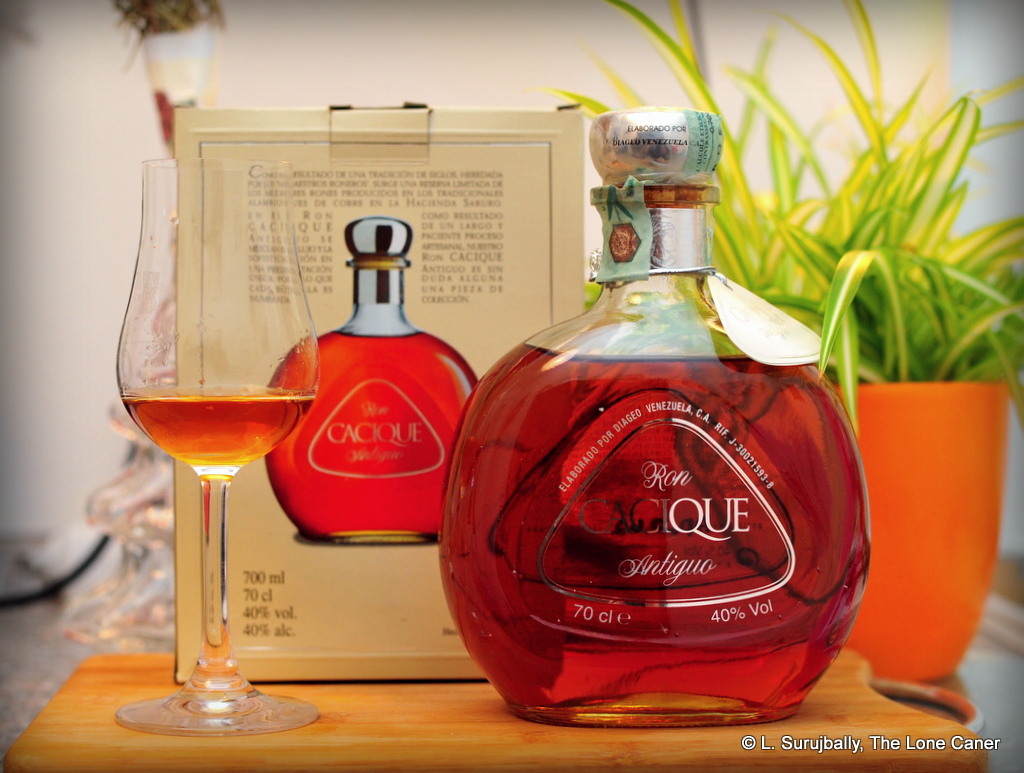
Supposedly more premium, but not a whole lot better than the 500.
Here’s a poster child of why a rum reviewer has to have the beady-eyed practicality of a jaded streetwalker. Age, style, marketing, pamphlets, labels, word of mouth, all count for nothing, and all is evaluated without recourse to what anyone else says.
After reviewing the €35 Cacique 500 as well as the Veroes Añejo from Venezuela, and checking around to see what else I could buy from that country, I felt it was only fair to pick up something a little higher up on the value chain (but only one), just to see how the Cacique brand developed as it got older: the Antiguo, selling for around €61, is a 12 year old rum aged in French white oak (Bordeaux, it’s been said) and quite an interesting rum, if not particularly ground breaking in any way: it does however present somewhat better than its predecessor.
My bottle was a cardboard-box-enclosed chubby flagon with a metal wrapped cork topping, so evidently the makers took some time to make the appearance match its marketing pedigree. All good there. It poured out a golden brown spirit with a nose that was light and easy, utterly unaggressive, redolent of perfumed bougainvilleas, lavender and honey. It was quite pleasant, except perhaps even smelling it suggested an overabundance of sugary sweetness, a cloying scent of, well, too many flowers. And it was still a little lacking in the intensity I prefer. Still, it settled down very nicely after some minutes (I was tasting some other rums at the time, so sat it down and came back later) – it got warmer and more solidly aromatic after ten minutes or so. Some nuts, tarts with strawberries but more tart than berry, cereal…you know, like those Danish butter cookies with some jam in the center. And even some lemon peel lurking in the background.
The taste was a country mile ahead of the nose. At 40% I more or less expected a tame, soft drink, and I got that, as well as an unusually sharp introduction which fortunately faded away quickly, leaving just warmth. It was still a very light bodied rum – I suppose we could call it ‘Spanish style’ – flowery, delicate to taste. I want to use the word ‘round’ to describe how the texture felt in the mouth, coating all corners equally, but let’s just say it provided the sensation of a thin honey-like liquid, warm and mild, quite tasty, too luscious to be dry. A pinch of salt, a dab of butter, a spoon of cream cheese, mixed in with a cup of sugar water and honey, a squeeze of lime, and a grating of nutmeg and crushed walnuts. It was good, I went back a few times and recharged the glass (in a period spanning several days), just not something to rave over. Admittedly, what I’ve described wasn’t all – over time and with a little water, some oak peeked out from under the sweet skirts, vague peaches and molasses, and an odd, woody, even anise note popped in and out of view, here now, gone a second later. The finish was something of a let down – medium short, a little dry, flowers, some salt butter and a shade of vanilla; unexceptional really.
You’re going to buy and enjoy this one for the taste, I think, not how it ends. That midsection is decent and lifts it above what I thought were lacklustre beginnings and endings, and perhaps more attention should be paid to beefing this rum up a little. It is a perfectly serviceable 40% rum, and I’ve read many Venos extolling its virtues online.
But it’s nearly twice the price of the 500, and not twice as good. I look for certain things in a rum, and this didn’t provide all that many of them. I’m unclear for how many years this rum has been in production: fairly recently, I think, though it has been noted that the traditions behind the company go back many decades. For now I can say that what the Cacique Antiguo has shown us is relatively new (and interesting), but that, in fine, doesn’t mean that what they have presented is news.
(#240 / 84/100)
Other notes
- I’ve gone into the company and production background a little in the 500 essay, so I won’t repeat it here.
- There’s a lot of the profile of the Santa Teresa 1796 here, or maybe the Diplomaticos. Too bad I didn’t have them around to do a comparison, but it would be instructive to try that one day.
- It is supposedly made on old copper pot stills, but I must say that the taste doesn’t really support that. I accept it…but with reservations
- The brand is now owned by Diageo.